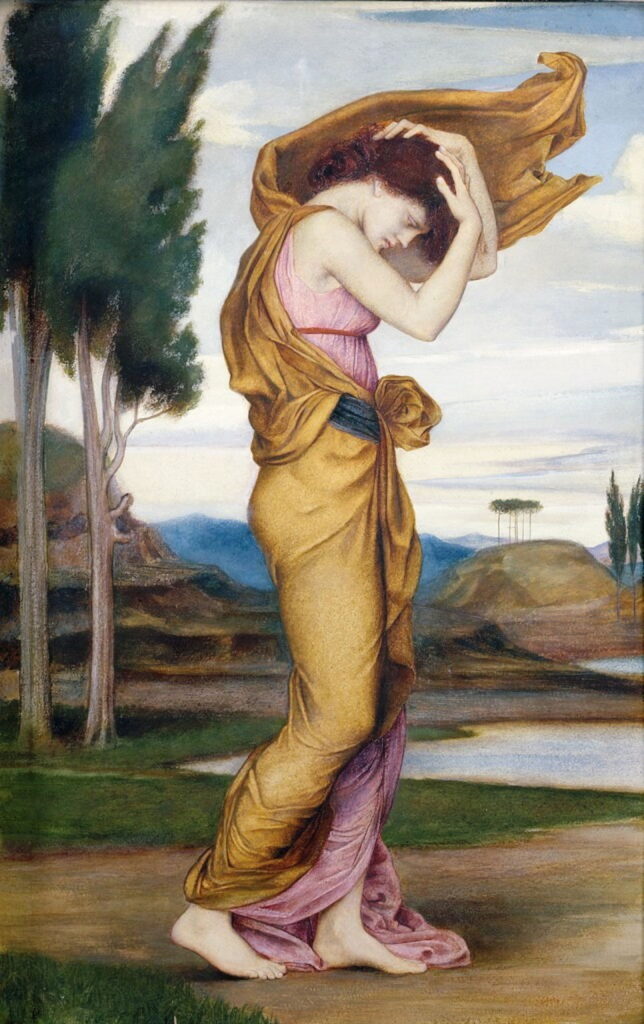Heroines 9: Blood of a centaur and the troubled woman

Paintings only too easily become separated from their original titles. Devoid of that crucial clue, Evelyn De Morgan’s full-length portrait of an overtly troubled woman, above, becomes an insoluble mystery. We see a classically-dressed woman, walking slowly in a non-descript landscape. Both her hands rest on the top of her bowed head, as if she’s wrestling with inner turmoil. She stares down at the ground just in front of her feet. The wind has blown loose robes high over the top of her.
Even when we know the title, which is just her name, Deianira, we are little the wiser. The only well-known story involving her is of her attempted abduction by the Centaur Nessus. With neither Nessus nor her husband, Hercules/Heracles, shown, the painting is no less cryptic.
Evelyn Pickering, as she was then, studied at the Slade School of Fine Art in University College, London, between 1873-76; the Slade’s first professor was Sir Edward Poynter, who taught there from 1871-75, and painted several unusual if not obscure classical motifs.
Looking at a short and incomplete list of Evelyn De Morgan’s paintings, there are five showing Ovid’s Heroines, characters for whom he wrote fictional letters in his Heroides:
Ariadne in Naxos (1877) – letter 10,
Deianira (1878) – letter 9,
Hero Holding the Beacon for Leander (1885) – letters 18, 19,
Medea (1886 or 1889) – letter 12,
Helen of Troy (1898) – letters 16, 17.
With Poynter her inspiration, Evelyn De Morgan seems to have dipped into Ovid’s unique collection of stories about women. So why should Deianira appear so troubled?
Jan Gossaert (1478–1532), Hercules and Deianira (1517), oil on oak panel, 36.8 x 26.8 cm, Barber Institute of Fine Arts, Birmingham, England. Wikimedia Commons.
Considering how frequently Hercules is reported to have had relationships with women and men, his marriage to Deianira was one of his most enduring. For some artists, it was very physical: Jan Gossaert’s Hercules and Deianira (1517) spares little to the imagination.
Some of Hercules’ relationships were unusual, to say the least. One episode which Ovid’s letter alludes to is a period spent as a cross-dressed slave to Queen Omphale.
Lucas Cranach the Elder (1472–1553), Hercules and Omphale (1537), oil on beech wood, 82 × 118.9 cm, Herzog Anton Ulrich-Museum, Braunschweig, Germany. Wikimedia Commons.
As Lucas Cranach the Elder’s bizarre Hercules and Omphale (1537) shows, this paragon of manly attainment, most notably in his twelve labours, was dressed as a woman, and performed womanly tasks such as spinning.
To make sense of Deianira’s story, we must return to the incident involving her attempted abduction by the Centaur Nessus when he was carrying her across the river Euenos, in western Greece.
Peter Paul Rubens (1577–1640) (workshop of), The Abduction of Deianeira by the Centaur Nessus (c 1640), oil on panel, 70.5 x 110 cm, Niedersächsisches Landesmuseum Hannover, Hanover, Germany. Wikimedia Commons.
This marvellous painting was probably made by Rubens’ workshop around the time of the Master’s death in 1640. It views the events from the bank where Hercules is poised to shoot his arrow into Nessus. This has the centaur running across the width of the canvas, his face and chest well exposed for Hercules’ arrow to enter his chest.
To make clear Nessus’ intentions, a winged Cupid has been added, and Deianeira’s facial expression is marvellously clear in intent. An additional couple, in the right foreground, might be intended to be a ferryman and his friend, who appear superfluous apart from their role in achieving compositional balance.
Sebastiano Ricci (1659–1734), Hercules Fighting with the Centaur Nessus (1706-7), fresco, dimensions not known, Palazzo Marucelli-Fenzi, Florence. Wikimedia Commons.
In about 1706, Sebastiano Ricci embroidered this story further, showing Heracles, his left hand grasping Nessus’ mouth, about to club the centaur to death, while a slightly bedraggled Deianeira watches in the background. There’s no arrow in Nessus’ chest, and Heracles’ quiver is puzzlingly trapped under Nessus’ right foreleg. Three other figures of uncertain roles are at the right, and a winged putto hovers overhead, covering its eyes with its right hand.
The attempted abduction by Nessus set a trap which was later to bring about the deaths of both Hercules and Deianira. As he lay dying, Nessus gave Deianira a vial of his blood, advising her that it ‘would ensure that Hercules was true to her forever’. Well-versed readers at the time of Ovid would have recognised this immediately, knowing how toxic the blood of a Centaur is, but Deianira was too naïve to know that, and took the Centaur’s words at face value.
Artist not known, Deianira Sends her Husband Hercules the Tunic Impregnated with the Blood of the Centaur Nessus (c 1510), miniature in Octavien de Saint-Gelais’ translation of Ovid’s Heroides (1496-1498), Folio 108v, Bibliothèque nationale de France, Paris. Wikimedia Commons.
Years later, when she heard that Hercules was having an affair with Iole, Deianira decided to try Nessus’ parting gift on her errant husband. When he called for a tunic (or shirt, or similar), she impregnated the garment with some of the blood, and sent it to Hercules. This is shown in this beautiful miniature accompanying Octavien de Saint-Gelais’ translation of Ovid’s Heroides from about 1510. It is at this stage that Ovid’s fictional letter from her to Hercules starts.
As soon as Hercules donned the impregnated tunic, he suffered intense pain from the poison, and he was unable to remove the garment from his skin. The pain wasn’t so severe as to stop him from murdering Lichas, the herald who had brought him the tunic, by throwing him into the sea. But Hercules was unable to find any relief, and resolved to burn himself on his own funeral pyre in desperation.
Master of the English Chronicle (dates not known), The Death of Hercules (c 1470), in Histoires de Troyes, illuminated manuscript by Raoul Le Fèvre, Bruges folio, Folio 233v, location not known. Wikimedia Commons.
This is illustrated in another miniature, The Death of Hercules (c 1470), this time for Raoul Le Fèvre’s Histoires de Troyes.
Francisco de Zurbarán (1598–1664), The Death of Hercules (1634), oil on canvas, 136 × 167 cm, Museo Nacional del Prado, Madrid, Spain. Wikimedia Commons.
Its most famous depiction, though, is in Francisco de Zurbarán’s powerful The Death of Hercules (1634). Using chiaroscuro as stark as any of Caravaggio, Zurbarán shows what can only be a Christian martyrdom, with its victim staring up to heaven, commending his soul to God.
Giovanni Domenico Tiepolo (1727–1804), The Apotheosis of Hercules (c 1765), oil on canvas, 102 x 86 cm, Museo Thyssen-Bornemisza, Madrid, Spain. Wikimedia Commons.
What happened to Hercules on his pyre has resulted in even more confused imagery, such as Tiepolo’s wonderful The Apotheosis of Hercules (c 1765). Because Hercules was the son of Jupiter/Zeus, as his body was burning, Jupiter decreed that only his mortal ‘half’ would be consumed by fire. His divine part was then conveyed in a chariot in an apotheosis to the gods on Olympus, often portrayed as a saintly ascension to Heaven. Once there, Hercules reconciled previous quarrels with Juno/Hera, and, as a god in his own right, married Hebe (the Roman Juventas), his half-sister.
Evelyn De Morgan (1855–1919), Deianira (c 1878), oil on canvas, dimensions not known, Private collection. Wikimedia Commons.
The Deianira of Ovid’s Heroides and Evelyn De Morgan’s painting was then left in deep trouble. Hearing the news of Hercules’ death in the midst of writing her letter, she had but one option: suicide. With Hercules a god, and even Iole being cared for by Hercules’ son, Deianira was left alone, to die by her own hand. No wonder she looks troubled.



